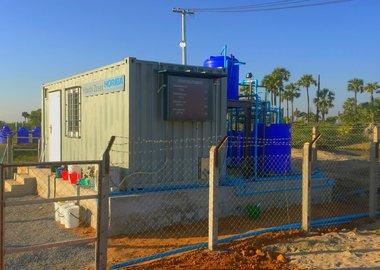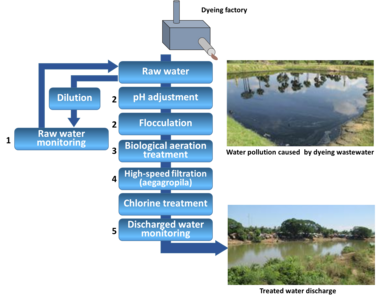January, 2017 - HORIBA, Ltd. and Hitachi Zosen Corporation have jointly made a business proposal for the “Model Project for Improvement of Water Environment in Asia (Fiscal 2016)” promoted by Ministry of the Environment of Japan (MOE). As part of the government’s growth strategy, this project aims to assist companies to enter the water business market in Asia.
Verification test equipment in Wundwin
The proposal by HORIBA and Hitachi Zosen, which was based on research on river pollution conditions near dyeing factories in the city of Wundwin, Republic of the Union of Myanmar (Myanmar), and on a feasibility study, was adopted by the MOE in March 2016. Starting in January 2017, a test to verify improvement in water quality commenced with the use of HORIBA’s water quality measuring instruments and Hitachi Zosen’s industrial water treatment system.
The project aims to improve water pollution caused by wastewater from dyeing factories in Myanmar, realize a local business by using the relevant technologies of both companies, and ultimately promote the development of Myanmar’s textile and dyeing industry and environmental preservation.
Business Background
Wundwin, a city located in the heart of Myanmar, is also the heart of the country’s traditional garment production. Many of the cities 230,000 inhabitants are directly or indirectly linked to the textile industry, which primarily produces the countries iconic traditional costume, the longyi. There are approximately 6,300 factories engaged in the production of textiles in the city, making it not only a chief driver of the local economy, but also intrinsically linked to the Burmese culture as a whole. As the fabric used in making the longyi is black, a dyeing process is necessary to create the colorful patterns seen everyday throughout the country. About 630 factories, or 10%, use a dyeing process.
However, wastewater discharged from the dyeing process at factories has caused serious water pollution problems in nearby rivers.
In Myanmar, specific regulations, standards, or penalties for industrial waste have not yet been established, and most factories are not equipped with wastewater treatment facilities. There are only a few operators who perform maintenance and management of those facilities.
In light of the situation in Wundwin, HORIBA became interested in proposing a solution. The company possesses water quality measurement and analysis technologies and has some experience of environmental surveys in Myanmar. Thus, with support from MOE, HORIBA has decided to start a verification test jointly with Hitachi Zosen.
Business outline
With the aim of improving water pollution caused by Myanmar’s industrial development, we will introduce verification test equipment for wastewater treatment and a water quality monitoring system. In addition, we will instruct local engineers who will be assigned with the improvement, operational management, and maintenance management of water pollution caused by water discharged after dyeing.
Major Works
- Survey of dyeing factories’ scale and amount of discharged water, and status of river water pollution
- Determination of specifications for verification facilities, based on analysis of dye and wastewater of the target factories
- Introduction of verification testing facilities and confirmation of their effects (river survey)
- Technical assistance with operation and maintenance management of the testing facilities
Technological outline
By combining quantitative data from HORIBA’s water quality measuring instruments and Hitachi Zosen’s wastewater treatment technology, a system that matches local needs will be established to appropriately treat wastewater from dyeing.
- Setting water conditions: Conduct measurement and determine conditions of quality and amount of water
- Coagulation treatment testing: Check optimal points for pH, coagulation agent, and polymer
- Biological treatment testing: i) Check sludge loading (volumetric loading) and ii) optimize the amount of air for aeration*
- Rapid fiber filtration test
- Water quality monitoring before water discharge: Check water quality before discharge
* The amount of air when oxygen is supplied through the infusion of air to the water
Major instruments used in the project
- HORIBA
OPSA organic pollutant monitor
H-1 industrial water quality measuring instruments - Hitachi Zosen
Rapid fiber filtration system Marimo®
Project structure
- HORIBA will be in charge of business execution and measurement and analysis of wastewater from dyeing.
- Hitachi Zosen will be engaged in establishing the dyeing wastewater treatment system.
- The Ministry of Environmental Conservation and Forestry of Myanmar will assist with the survey and verification tests in Wandin.
Prospects for future development
Myanmar is expected to continue its economic growth and is at the stage of establishing regulations to prevent environmental problems from occurring in its development processes.
HORIBA and Hitachi Zosen intend to widely disseminate their technologies in Myanmar in order to improve and prevent water pollution; help enhance the skills of local operators and maintenance companies; promote the establishment of environmental regulations and emission standards; and contribute to the development of the dyeing industry in Myanmar.

